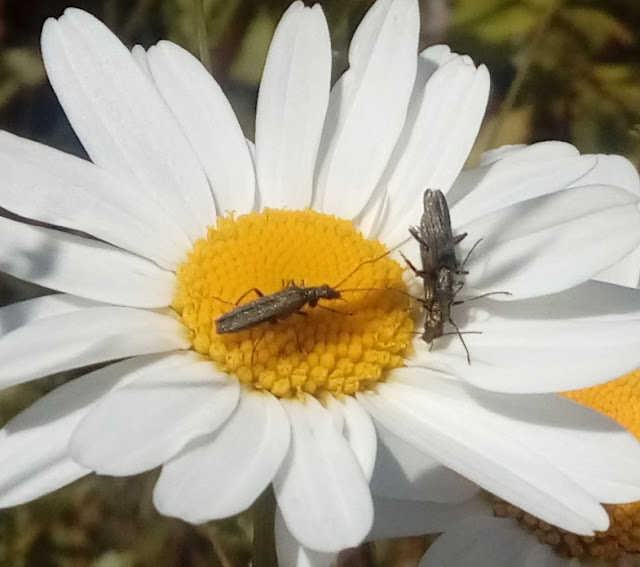The Safari was out yesterday morning joining a guided wildflower walk just a few hundred yards from Base Camp. The sun shone and the small group wandered around the Community Orchard to begin with before moving further afield.
After ticking off the obvious species like Nettles, Cow Parsley, Cleavers and Cock'sfoot grass in the orchard we spent time looking at Red Clover, Ox-eye Daisies, Lesser Trefoil and Crested Dog's Tail grass out in the open. On the hard clay of the open plateau is where the Bee Orchids can be found. Indeed we knew there were at least half a dozen or so lurking on the edge of the denser vegetation as we;'d found them earlier in the spring. But today try as we might we couldn't relocate them and it should have been easier as they ought to be in flower by now. Eventually we did find one and it took some serious tracking down as it was looking very much worse for wear. Perhaps the long dry spell had put paid to them.
All was not lost though as we did come across three spikes of the chlorophyll lacking parasitic Common Broomrape, we've seen it here before but not for a few years. We're pretty sure it parasitises the Red Clover here. It is very local and only ever appears in the same few square yards despite the Red Clover occurring across the whole area.
With family duties to attend to we had to leave the group early so we went back today for another look this time without Monty so we were less hindered for taking some pics.
Before that, in the morning, we'd taken him round Patch 1 where we heard a couple of Chiffchaffs, one of the Blackcaps and saw the Whitethroat which although we couldn't see if it was carrying food must surely be nesting by now.
The highlight of our visit wasn't the birds though as we spotted four Common Blues
 |
| Heavily cropped phone pic |
 |
| ditto |
As well as this cheeky three-some
 |
| Not entirely sure what #3 is up to here, the other two are probably not impressed |
Back at the wildflower area after lunch we heard a Whitethroat and two Chiffchaffs there too as we walked in. The first thing we wanted to check was the dyke that we noticed yesterday had been cleaned out recently - right at the worst time of year, we're not sure if that would have been legal, certainly the bush with the breeding Reed Buntings is no longer there!
Surely everyone knows work like that should be done in the winter and certainly by March at the very latest. The waste is piled up on the edge of the County Biological Heritage Site which is a long way from Best Practice too although it would have allowed any aquatic animals to get back into the water but buried much off the local patch of Meadowsweet/ It's hardly as if it was essential work as it's barely rained a drop for the best part of a month or more. Fortunately the other end of the dyke which is far more floristically diverse than this section hasn't been touched - - - yet???
Back at the Broomrapes we were able to get a few pics in the sunshine.
 |
| Despite its weirdness it's deffo a proper job flowering plant |
 |
| The third one, unopened |
Although it was sunny there weren't very many butterflies on the wing just a couple of Common Blues and this Speckled Wood in the Community Orchard
Pick of the afternoon's fimds was this mating wheel of Blue Tailed Damselflies.
A very pleasant fourth day (already!!!) of #30DaysWild out finding wild stuff and none of it more than a short walk from Base Camp
Where to next? Looks like torrential rain and strong winds are going to put the kibosh on tomorrows planned whale and dolphin watch for World Environment DayIn the meantime let us know who's doing what they perhaps shouldn't be in your outback








1 comment:
Cracking photo of the mating damsels Dave.
Post a Comment